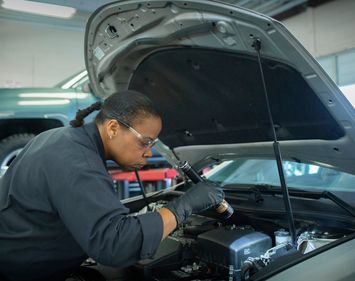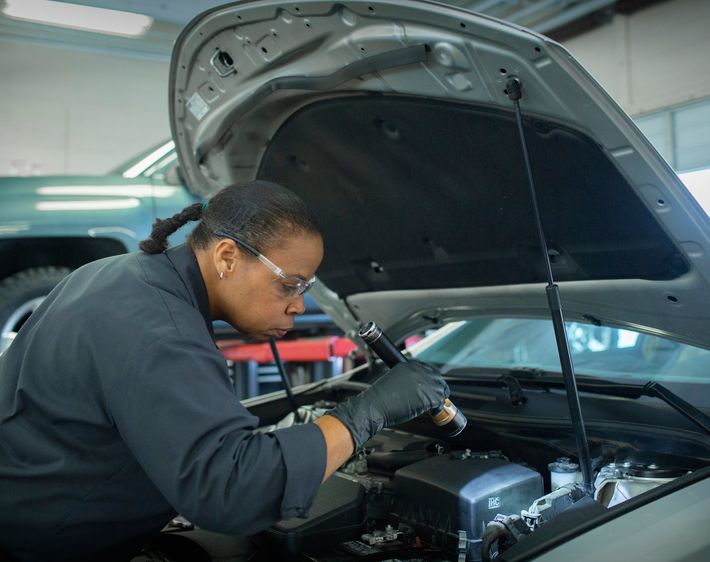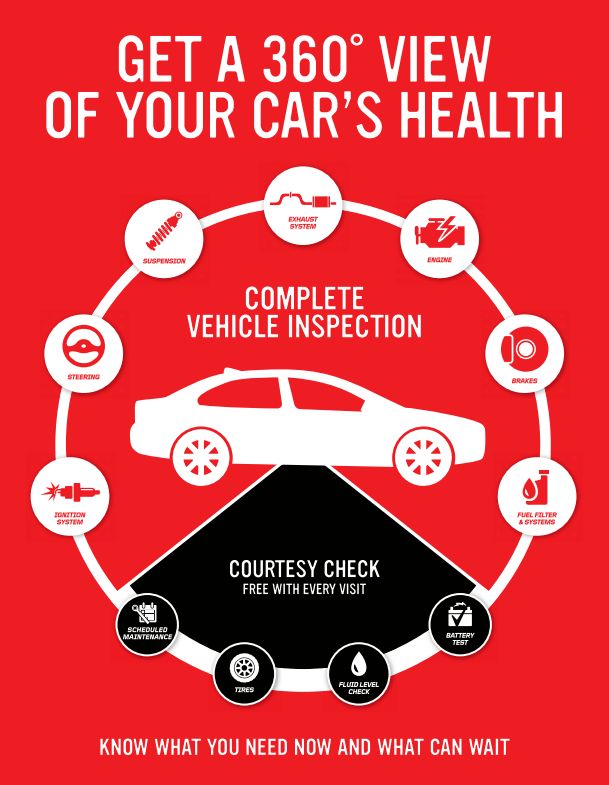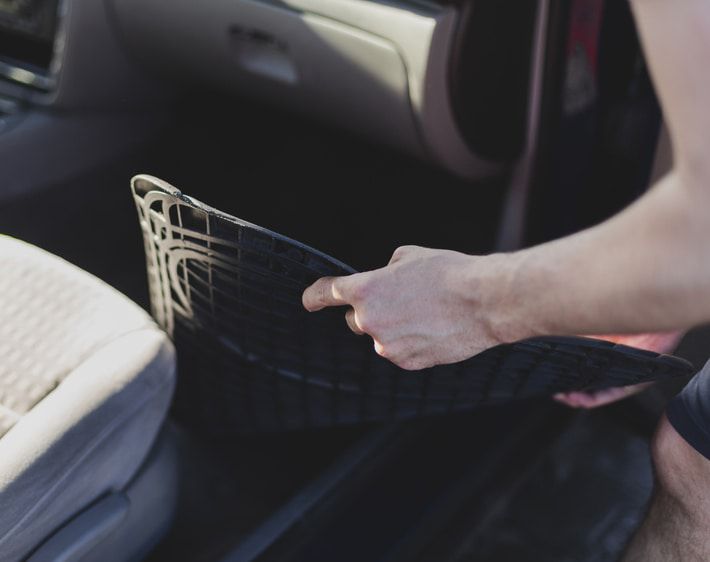
The In-and-Outs of a Complete Vehicle Inspection
When we say "complete," we mean it. Your car is checked from bumper to bumper, inside and out. Here's how it goes!
Basic Checks
First, one of our expert auto technicians checks your wiper blades, headlights, and air filter. But what are they looking for?
Wiper Blades:
The technician looks for bent, torn, or missing blades, and to see if the wiper arm is providing the right amount of pressure to maintain firm blade contact with the windshield.
Lights:
Where there's a bulb, there's an inspection. The technician checks operation of headlights, brake lights, license plate lights, parking lights, hazard lights, and more!
Air Filter:
Your air filter is removed and examined for dirt and debris. If the filter is missing or too dirty to perform its job, it probably needs to be replaced. We'll let you know.
Fluid Level and Condition Checks
Next, the technician dives into your vehicle's many fluids!
Windshield Washer Fluid:
Is your wiper fluid reservoir drier than Route 66 in mid-July? A technician inspects and refills your wiper fluid, if needed, and then confirms that the washer pump and hoses work properly.
Motor Oil:
Once your engine is cool, the technician checks the oil level on the dipstick and notes the oil consistency. They aren't so concerned with the oil color since color isn't the sole indicator that it's time for an oil change. Many oils are darker than others when new. Instead, the technician is checking for oil that appears thick, gritty, or milky. These oil consistencies could indicate you're overdue for an oil change.
Power Steering Fluid:
Your power steering fluid makes it easier to turn the wheel in your car. Without it, steering would take some muscle! The technician checks the fluid in the pump reservoir and looks for signs of leakage in the pump, hoses, gear box, and/or rack and pinion assembly. Grayish or blackish fluid could mean you have internal steering problems.
Master Cylinder Fluid:
The master cylinder is an essential part of your braking system. It's a pump that forces brake fluid to go where it needs to go, so you can stop when you want to stop. A technician inspects the master cylinder for leaks and damage. They look for fluid that's foamy, discolored, or showing signs of contamination—all of which could point to an issue in the brake system.
Brake Fluid:
Unlike Fred Flintstone, you can't actually use your feet to stop your vehicle. Instead, you push the brake pedal and brake fluid helps turn your push into pressure that moves the rest of the braking components, thereby slowing or stopping your car. If you’re low on brake fluid, you may notice that when you push the brake pedal, it feels soft or goes down all the way to the car floor. A technician checks if your brake fluid needs to be replaced per the manufacturer's guidelines. They might perform a test drive as well.
Transmission Fluid:
Transmission fluid works as both a lubricator and temperature regulator inside the engine. The technician follows your manufacturer's recommendations for checking the transmission fluid level, and may recommend fluid replacement if it’s brown or smells burnt.
Coolant:
Coolant/antifreeze levels must be maintained to help prevent your engine from overheating. A technician visually inspects the coolant fluid level. If the engine is warm, a level of 1.5" below the radiator filler neck is acceptable. If the engine is cold, they'll look to see that the radiator tubes are not exposed.
Hoses, Belts, and Wires Evaluation
A car part may be perfectly good, but if it's not correctly connected to the rest of the car, you might as well call it broken!
Belts:
With a poorly functioning belt tensioner or timing belt, your car's engine is going to struggle to perform its best. It could even fail. A technician checks that both belts are functioning properly and may recommend replacement if it's close to your manufacturer's scheduled maintenance.
Spark Plugs and Ignition Wires:
Together, spark plugs and ignition wires deliver the electricity your engine needs to start and then run, run, run! A technician looks for signs that either one is worn to the point of needing replacement—because a car that won’t start does not spark joy!
Power Steering Hoses:
Remember what we said about power steering fluid? It applies to the power steering hoses, too! Bad or leaking power steering hoses can make it much harder for you to steer your vehicle. A technician looks for signs of wear and tear along the hoses that could put your vehicle handling in jeopardy.
Battery Charge and Connections Check
Our car battery inspection is so thorough that it deserves its own section!
Battery:
A technician will pop the hood and examine the battery and surrounding area for:
- Excessive dirt/contaminants on the battery case
- Corrosion on the battery terminals, cables, or tray
- A leaking or swollen battery case
- Loose or melted battery posts
These are all signs it might be time for a battery replacement.
Battery Accessories:
Your battery accessories include the battery cables, insulation, terminal bolts, and hold-down hardware. A technician checks the length of the cables, verifies that the insulation is intact, and then inspects the terminal bolts for corrosion. They also examine the hold-down tray to ensure it's mechanically sound—a battery that bounces around can't do its job very well!
Battery Starting/Charging:
A technician performs a computerized battery test to gauge how much charge is left in your battery. The test can even determine the temperature at which your battery might fail.
Steering and Suspension Check
Let your technician know if something has felt "off" when you drive. If the problem has to do with your car's steering and suspension, this is when your technician will be able to troubleshoot the symptoms.
U-Joints:
The U-joints, or universal joints, hold the driveshaft in place—and the driveshaft is needed for your wheels to turn! Worn U-joints can make a clunking noise when shifting gears, or a squealing sound when driving slowly. A technician may perform a test drive, but will also check for looseness and rusting in each U-joint.
Ball Joints:
Ball joints function like human hip joints. They're a key part of your front suspension system and help you control your vehicle. Because the number and type of ball joints can vary from vehicle to vehicle, the technician first consults the manufacturer's specifications and inspection procedures before examining ball joints or recommending a replacement.
Constant Velocity Boots/Joints:
Constant velocity, or CV, boots are often the first thing that needs replacement in the suspension system. CV boots cover and protect CV joints, which help your car turn left and right. A technician inspects the boots for holes or tears that could allow contaminants to damage the joints.
Shocks and Struts:
Shock and strut wear can reveal itself in many ways, like vehicle rattling, swerving/dipping when braking, vibration in the steering wheel, or trouble stopping. A technician checks for structural damage and performs a test drive to personally "feel" for signs that shocks, struts, or mount assemblies need to be replaced.
Tire Maintenance Check
Your tires are the only things touching the road when you drive. That makes them one of your car's most important parts! Our technicians give tires the attention they deserve.
Tire Pressure:
It's our policy that all tires serviced in our facilities be inflated to the cold inflation pressure specified by the vehicle manufacturer. We'll check that your tire inflation matches the manufacturer's recommendations, and with your permission, adjust it as needed.
Tire Tread Depth:
Without proper tread depth, your tires can't grip the road like they're supposed to! A technician will measure the tread depth at three locations in the inner and outer tread grooves. If irregular tire wear is obvious, they'll measure the tread at the lowest point, as this is the root of most tire failure incidents. By law, technicians are not allowed to repair tires with 2/32" or less tread depth. The tires must be replaced.
Tire Condition:
You might not have a flat tire, but that doesn't mean you're driving on good tires. A technician will rotate and inspect each tire, marking areas showing cuts, punctures, uneven wear, curb damage, ply separation, cupping, breaks, and more. They will recommend a tire replacement if they notice:
- A tire tread depth of 2/32” or less
- Cord, ply, or tread separation
- Exposed cords or belting materials
Alignment:
An alignment adjusts the angles at which your tires come into contact with the road. A technician may recommend an alignment if they notice uneven tire wear, a crooked steering wheel, or if parts of your steering/suspension are being replaced.
Brake System Inspection
At Firestone Complete Auto Care, we believe that all power is useless without stopping power. That's why the final part of your inspection involves a thorough brake check where all four wheels are removed—it's the only way the technician can get a full view of your brake system's pieces and parts.
Brake Pads:
Most people are familiar with brake pads, the plates that apply pressure to the rotors to slow your car. Brake pads squeak and squeal when it's time for them to be replaced. A technician will measure brake pad thickness according to your manufacturer's recommendations. If your state has laws regarding minimum lining or pad thickness, they will consult these as well!
Brake Calipers:
Brake calipers squeeze the brake pads against the rotors to slow your car. A technician will examine the caliper assemblies for looseness, rust, and signs of leakage.
Brake Rotors:
At the same time, the technician will check brake rotors for scoring, overheating, and physical damage like cracks. Such signs could also signal caliper trouble.
Find Out What You Need Now & What Can Wait
It might be hard to believe, but this list still doesn't cover everything that's examined during a Complete Vehicle Inspection. Our technicians go above and beyond to give you a 360-degree view of your car's health so that you can decide what you need to do for your vehicle right now, and what can wait till your next visit.
Paying for a Complete Vehicle Inspection is a small price to pay for peace of mind on the road—and you can't put a price on that. Call today or schedule an appointment online for an affordable vehicle inspection at your nearest Firestone Complete Auto Care.




